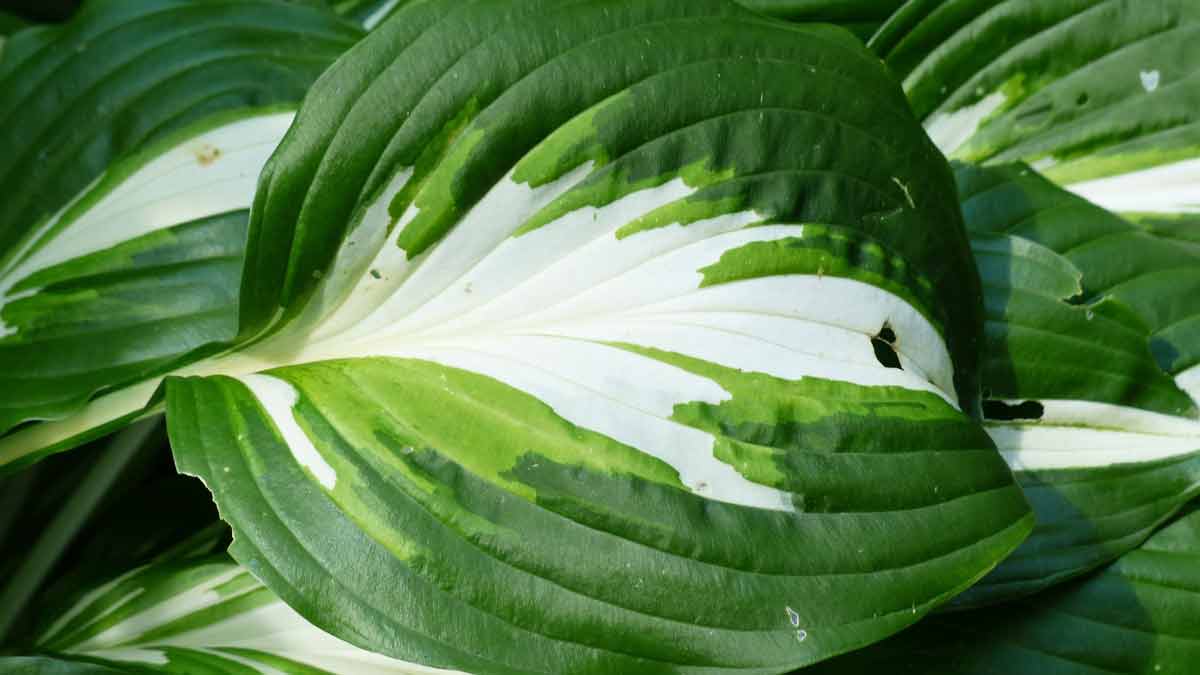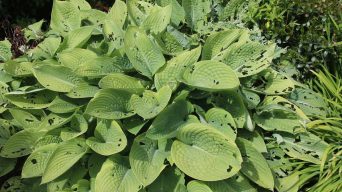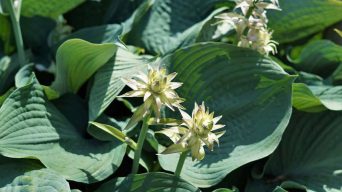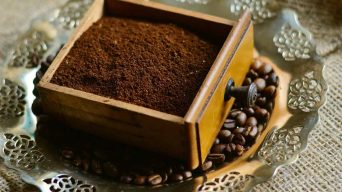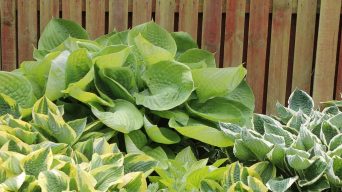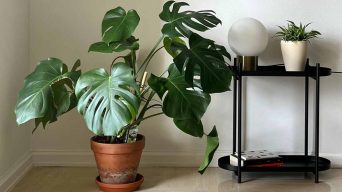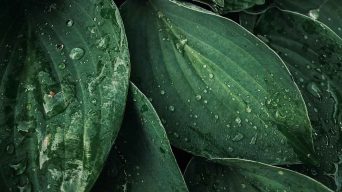Holes in hostas plants can be caused by various factors, including pests, disease, or physical damage. Snails and slugs are the most common culprits of hosta plant damage, but other insects and fungi can also cause leaf holes. Also, improper care or cultural practices, such as overwatering or too much sunlight, can contribute to developing leaf holes in hosta plants.
Holes in hostas leaves are a common problem caused by many factors, including pests, diseases, physical damage, and environmental stress.
While these holes may not seem like a big deal, they can cause severe damage to your hosta plants if left unchecked.
Not only do they detract from the plant’s overall appearance, but they can also weaken the hosta and make it more susceptible to further damage or even death.
Fortunately, you can take several preventative measures to keep your hostas healthy and free from holes.
Common Factors That Cause Holes in Hostas Leaves
Hostas are popular ornamental plants that can add beauty to any indoor or outdoor garden. Unfortunately, these stunning plants are susceptible to various conditions that can cause holes in their leaves.
Knowing what causes the damage is essential to preventing it so you can maintain healthy hosta plants. The most common factors that can cause holes in hosta leaves are:
The Role of Garden Pests in Leaf Damage
Garden pests such as slugs, snails, caterpillars, and rabbits are a significant source of damage for hostas. These creatures feed on the leaves and cause noticeable holes.
Certain pest insects may leave eggs on the underside of hosta leaves that could hatch into larvae and further damage your plants.
Common pests that may cause holes in hosta leaves are:
1. Slugs
Slug damage to hostas leaves can be identified by small holes in the foliage, which can range from small to large and have irregular shapes.
When the slug population is large, the damage can be quite considerable.
The slugs will be active when temperatures exceed 50 degrees and at night or during cloudy days. They will hide within crevices around plants, such as mulch, dirt, or under rocks during the day.
2. Snails
Snail damage is usually identified by smaller, circular holes often surrounded by slime trails. It is most common in warm and moist climates.
These creatures can hide under rocks or logs during the day and feed on hosta leaves at night.
Snails differ from slugs in that they have a hard shell, which can protect them from predators and dry conditions.
3. Cutworms
Cutworms are moth larvae that can be found in both gardens and agricultural fields. They are typically between one to two inches long, dark brown or gray, and feed mainly on leaves but can also damage stems.
The activity of cutworms causes holes to form on hosta leaves which are noticeably more significant than those caused by slugs and snails.
Cutworms may also eat between the leaf veins, causing long holes that negatively affect the plant’s appearance.
4. Cockroaches
Cockroaches can cause damage to many types of plants, including hostas. These pests feed on plant material and create irregularly shaped holes that may have a yellowish hue.
The cockroach population tends to increase during summer, making them particularly troublesome for gardeners.
Additionally, their fast reproduction rate means that their numbers can quickly become overwhelming if left unchecked.
5. Blister Beetles
Blister beetles are garden pests with a brownish to black body with four to five yellowish diamond-shaped spots on the top of the body and a dark colored ‘W’ on top of their bodies near the posterior end.
Some species also have short wings and forceps like pincers at the tip of their abdomens, measuring up to two inches long.
Blister beetles tend to chew irregular holes in hostas leaves and flowers during the early to mid summer months.
They may also feed on nectar or pollen on hostas, causing damage to the flowers.
These pests can be found in clusters and usually feed during the day.
6. Vine Weevils
Vine weevils are insects that chew irregular holes in leaves. They are reddish-brown, with short wings and forceps-like pincers at the tip of their abdomen, measuring approximately 5/16 inches long.
Vine weevils can cause extensive damage to plants by feeding on leaves and young shoots, resulting in wilted or discolored foliage. They also spread disease by contaminating plants with their saliva and feces while feeding.
Vine weevils are primarily active at night and tend to hide in crevices around plants during the day, making them difficult to detect.
7. Grasshoppers
Grasshopper damage to hosta leaves is characterized by tiny holes that are elongated and irregular in shape. The bugs can be identified by their copper coloration and the yellow diamonds on their backs.
Grasshoppers feed on hosta leaves during very wet springs when their populations spike, causing significant damage to foliage. They are most active during the day and can be controlled using various methods, such as trapping or insecticides.
8. Caterpillars
Cutworm caterpillar damage to leaves is characterized by small elongated holes chewed into the leaves.
The caterpillars are about 1.5 to 2 inches long and have yellowish diamonds on their backs.
They typically do most of their damage in spring before they pupate but can continue to feed on hosta leaves throughout the summer.
9. Tomato Hornworms
Tomato hornworms are the larval stage of a moth, measuring 1.5-2 inches long, and have dark brown or gray coloring. They chew small elongated holes in hostas leaves, leaving yellowish diamonds on their backs.
Tomato hornworms are most active in late spring and early summer but can still be found on hostas throughout the season. They feed at night and hide during the day, making them difficult to detect.
10. Rabbits
Rabbit leaf damage is caused by their chewing on hosta leaves. The pests leave irregularly shaped holes typically larger than those caused by other bugs and can defoliate an entire plant quickly.
Rabbits feed primarily at night, though they may also be active during the day. They have strong incisors, which allow them to chew through leaves and stems, making them difficult to control.
In addition to causing aesthetic damage, rabbits can also spread harmful diseases to hostas.
Fungal and Bacterial Infections
Holes in hostas leaves can be caused by fungal and bacterial infections.
Fungal infections are more prevalent during humid weather and are characterized by spots, discoloration, or leaf lesions.
Bacterial infections typically cause yellowing of the margins of the leaf and irregularly shaped brown spots near the edges that may eventually turn into holes.
Some common hosta fungal and bacterial infections include:
1. Fusarium Wilt
Fusarium wilt is a fungal disease that affects plants, especially young leaves. It causes brown or black spots on the leaves and small holes in some cases.
Fusarium wilt is caused by the fungus species Fusarium oxysporum, which releases toxins that attack the plant’s vascular system and cause wilting leaves and eventual death.
The fungus can spread through contaminated soil or infected plant debris, so it is crucial to take preventative measures such as crop rotation, proper watering, fertilization techniques, and cleaning up any dead leaves or plants immediately.
2. Gray Mold
Gray mold is a fungus that causes brown or black spots on leaves and small holes. It is usually found in moist environments and can spread quickly if left untreated.
Gray mold differs from fungi and bacteria because it has a distinct brown or dark gray edge around the hole or spot.
Additionally, its circular shape differs from other types of holes caused by pests such as insects or mites.
3. Powdery Mildew
Powdery mildew is a type of fungus that grows on plant leaves, causing them to become covered in a powdery film.
The fungus sprouts from spores in late spring or early summer when the weather is warm and humid. It can affect almost all plants, spoiling their appearance and causing hosta leaves to turn white or yellow with small holes.
In extreme cases, it can even cause leaves to drop off the plant. To prevent powdery mildew from forming on hosta leaves, provide them with plenty of space for air circulation and keep the foliage dry by avoiding overhead watering.
4. Bacterial Blight
Bacterial blight is a bacterial infection caused by the bacterium Xanthomonas campestris. It affects hosta leaves, causing them to turn yellow and develop small holes or lesions.
The disease can spread quickly if left untreated, killing the plants or severely damaging their appearance.
To prevent bacterial blight, it is important to keep the foliage dry and avoid overhead watering. Additionally, use a fungicide or organic solution when necessary to help control the spread of infection.
5. Bacterial Leaf Spot
Bacterial leaf spot is caused by a bacterial infection and appears as black or brown spots on the hosta leaves.
The spots can grow and spread, eventually leading to leaf holes. This disease spreads quickly and can kill plants if left untreated.
To prevent bacterial leaf spot, water the hostas at the base of the plant rather than overhead and use a fungicide or organic solution when necessary to help control the spread of infection.
Physical Damage to Your Hostas
Physical damage is another common cause of holes in hostas leaves. This may include damage from lawnmowers, weed whackers, and other garden tools and activities that can affect the foliage.
To help prevent this type of damage, it’s essential to keep all garden tools away from the hosta plant and be sure to pay attention when working in the area.
Additionally, using mulch around the plants can provide an extra layer of protection against physical damage.
Another way to prevent physical damage is by ensuring the hostas are located in an area that is not frequently trafficked by people or pets. Additionally, it’s important to keep the hostas away from areas easily disturbed by wind or weather, such as near driveways, sidewalks, or decks.
Environmental Factors That Contribute to Hosta Leaf Holes
Environmental factors can play a role in causing holes in hostas leaves. These factors include excessive sun exposure, too much or too little water, and extreme temperatures. Hostas prefer moist, well-drained soil and partial shade. Too much sun can cause the leaves to dry out or burn, leading to leaf holes.
Some environmental factors that may play a role in the development of holes in hosta’s leaves include:
1. Too Much Direct Sunlight
Hostas prefer indirect light and can suffer from too much sun exposure. If the leaves are exposed to too much direct sunlight, it can cause the leaf tissue to dry out and lead to holes in the foliage.
They should be planted in a spot with partial sun, such as morning sun and some afternoon shade.
2. Too Much Water
Hostas prefer moist, well-draining soil. Too much water can lead to root rot, which causes the leaves to become discolored and fall off, creating holes in the foliage.
Poor drainage can also cause water to accumulate around the roots. This can lead to root rot and eventual death of the plant, leaving behind holes in its leaves.
Overwatering hosta plants can also lead to fungal infections, which can cause leaf spots or holes in the leaves.
3. Too Little Water
In addition to overwatering, hostas can also suffer from too little water. When soil is allowed to dry out completely, it will stress the plant and compromise its health, leading to holes in the hostas leaves.
It’s essential to water hostas regularly and keep the soil moist but not soggy. You can check the soil moisture with your finger or a water meter to get an idea of when the plant needs to be watered.
4. Cold Temperatures
Hostas are not cold-hardy plants and can suffer from extreme temperatures. When temperatures drop below freezing, it can cause the leaves to freeze and die off, leaving behind holes in the hosta foliage.
It’s important to mulch around hosta plants in colder climates to help insulate the roots from frost damage. It’s also essential to choose suitable plants for your weather and ensure they have enough protection from the cold.
5. Wind
Wind can harm hosta leaves. The force of the wind can cause the leaves to tear, ripping them apart and leaving holes in their place.
Protecting hosta plants from strong winds can help to prevent this type of damage. Consider planting your hostas in a sheltered area near a fence or wall or adding wind-breaking plants to provide extra protection.
Strategies for Preventing Holes in Hosta Plant Leaves
Growing hosta plants can be a rewarding experience, but it is important to take steps to prevent holes from forming in the leaves.
Here are some tips to help you keep your hostas looking their best:
1. Avoid Soil and Plant Debris
Keeping the soil around your hostas free of debris is important to prevent disease and insect problems. Make sure you rake away fallen leaves or twigs before they rot.
This will help keep the area around your hostas clean and prevent pests from taking up residence.
2. Control Pests and Insects
Inspect your hostas regularly to look for signs of pests and insects. If you find any, take steps to control them right away. This could include removing the infested leaves or using an insecticide specifically formulated for hostas.
Neem oil or insecticidal soap are two natural options for controlling pests.
3. Water Your Hostas Properly
Hostas need regular watering to stay healthy and prevent holes from forming in the leaves. Water your hostas deeply, but don’t let them sit in wet soil.
It is also important to water during the morning or early afternoon, so the plant has time to dry before nighttime.
Hostas must be watered at least once or twice a week, depending on the weather.
4. Provide the Right Amount of Sunlight
Providing adequate sunlight can help prevent holes in hosta leaves.
Hostas do not tolerate direct sunlight and can get sunburned if exposed for too long. This can lead to the browning and dying of parts of the leaf and the overall weakening of the plant.
Eventually, this could lead to holes appearing in the leaves due to decay or pest infestation.
Place your hostas in a spot that gets dappled sunlight or filtered shade for most of the day.
Hosta plants thrive in areas that get morning sun and afternoon shade.
5. Fertilize Properly
Fertilizing your hostas is important for keeping them healthy and preventing holes from forming. A balanced fertilizer (10-10-10) should be applied in early spring before the new growth appears.
You can also use a slow-release fertilizer throughout the growing season to provide additional nutrients.
If the plants are not appropriately fertilized, they will be more susceptible to disease and infection, leading to holes in their leaves.
6. Prune Regularly
Regular pruning can help improve hosta plants’ overall health and encourage new growth. Trim off any damaged or discolored leaves, and thin out any overcrowded sections.
You can also remove any dead or diseased leaves to help reduce the chances of holes forming.
Pruning can help to promote air circulation and light penetration, which are important for keeping your hostas healthy.
7. Plant Resistant Hosta Varieties
If you have the space or opportunity, planting resistant varieties of hostas is an effective way to prevent hole-causing pests from attacking your plants.
Some varieties are bred to have high levels of pest resistance, so look for these when selecting hostas for your garden.
If you’re looking for a hosta variety that is resistant to disease and pests, here are some great options:
- Variegated Hosta (Hosta variegata): This variety features leaves with yellow or white edges and veins and is ideal for shady spots.
- Glossy Hosta (Hosta lancifolia): This variety has glossy leaves that are dark green in color and can tolerate full sun.
- Pineapple Hosta (Hosta ventricosa): This variety has large leaves that resemble a pineapple shape, making it ideal for large containers or landscape beds.
8. Use Snail and Slug Traps and Baits
Traps and baits can help prevent holes in hosta leaves by attracting and killing snails and slugs.
Using traps and baits will reduce the number of slugs and snails in the area, reducing the risk of damaging the plant leaves.
Most traps and baits are made from materials like beer, sawdust, or other organic ingredients.
They can be placed in garden beds or around the perimeter of your hosta plants to ward off snails and slugs before they have a chance to do damage.
9. Apply Diatomaceous Earth
Diatomaceous Earth is a natural product composed of fossilized remains of diatoms, a type of hard-shelled algae.
It is available in powder form and can be sprinkled onto hostas to prevent slug and snail damage.
The sharp edges of the DE act as physical barriers to reduce damage from pests.
Reapply after rainfall or watering to ensure the DE remains effective. Wear a dust mask and gloves when handling DE, as the powder can be an eye, skin, and lung irritant.
Additionally, it is important to note that Diatomaceous Earth does not discriminate between beneficial insects and pests.
Therefore, if using this prevention method, you should avoid areas inhabited by helpful creatures such as bees and butterflies.
10. Monitor Your Hostas
Finally, the best way to prevent holes in hosta leaves is to monitor your plants regularly.
Check for signs of pests such as slugs, snails, and caterpillars, as well as any leaf discoloration or damage.
If you notice anything out of the ordinary, take action to address the issue before it becomes a more significant problem.
Catching problems early can save you time and money in the long run and keep your hostas looking their best.
Final Thoughts
Growing and caring for hostas can be a rewarding experience. With the right know-how, you can ensure that your plants remain healthy and beautiful.
Preventing holes in the leaves of your hosta is an integral part of its overall care, so it’s worth taking the time to understand what could be causing them and how to address any issues.
Regular maintenance, such as providing enough water, paying attention to soil health, and addressing potential pests, are all crucial steps that can be taken to ensure your hostas stay healthy and beautiful.
Additionally, look for environmental factors that may cause damage, such as too much or too little sunlight or wind.
Finally, you can also keep your hostas looking their best by cutting off damaged leaves to prevent the spreading of disease and fungi.
With a bit of knowledge and effort, you can ensure that your hostas stay in tip-top shape and can enjoy their beauty for years.

